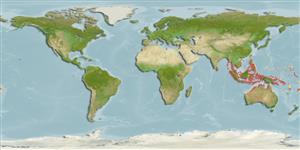Actinopterygii (ray-finned fishes) >
Perciformes (Perch-likes) >
Gobiidae (Gobies) > Oxudercinae
Etymology: Periophthalmodon: Greek, peri = around + Greek, ophthalmos = eye + Greek, odous = teeth (Ref. 45335).
Environment / Climate / Range
Ecology
Marine; freshwater; brackish; demersal; amphidromous (Ref. 51243); depth range 0 - 2 m. Tropical, preferred ?
Indo-West Pacific: Singapore, Bedok, Changi, Pulu Obi, Pulu ayer Merbau, Banka, Sumatra, Java, Jakarta, Madura, Borneo, Celebes, Ambon, Waigeu, New Guinea, India, Peninsular Malaysia, Sarawak, and Thailand (Ref. 3178). Known from the Mekong (Ref. 12693).
Size / Weight / Age
Maturity: Lm ? range ? - ? cm
Max length : 27.0 cm TL male/unsexed; (Ref. 7050)
Found in the sea, estuaries, and lower reaches of rivers (Ref. 4833). Commonly found on muddy shores in estuaries and in the tidal zone of rivers (Ref. 12693). Lives in burrows in the mud and emerges on sunny days at low tide. Moves quickly across the mud, but can be caught with entangling nets strung above the ground or with cast-nets tossed onto the exposed mud (Ref. 12693). An amphibious air-breather that actively shuttles back and forth between rock pools and air (Ref. 31184). Gulps air at the surface of its burrow and then transports the air to the bottom of the burrow in order to aerate its eggs; preys upon fiddler crabs, insects and worms (Ref. 92840).
Life cycle and mating behavior
Maturity | Reproduction | Spawning | Eggs | Fecundity | Larvae
Kottelat, M., A.J. Whitten, S.N. Kartikasari and S. Wirjoatmodjo, 1993. Freshwater fishes of Western Indonesia and Sulawesi. Periplus Editions, Hong Kong. 221 p. (Ref. 7050)
IUCN Red List Status (Ref. 115185)
CITES (Ref. 94142)
Not Evaluated
Threat to humans
Harmless
Human uses
Fisheries: minor commercial
More information
Common namesSynonymsMetabolismPredatorsEcotoxicologyReproductionMaturitySpawningFecundityEggsEgg development
ReferencesAquacultureAquaculture profileStrainsGeneticsAllele frequenciesHeritabilityDiseasesProcessingMass conversion
Tools
Special reports
Download XML
Internet sources
Estimates of some properties based on models
Phylogenetic diversity index (Ref.
82805): PD
50 = 0.6250 [Uniqueness, from 0.5 = low to 2.0 = high].
Bayesian length-weight: a=0.01698 (0.00928 - 0.03109), b=3.05 (2.88 - 3.22), in cm Total Length, based on LWR estimates for this species & (Sub)family-body (Ref.
93245).
Trophic Level (Ref.
69278): 2.5 ±0.2 se; Based on size and trophs of closest relatives
Resilience (Ref.
69278): Medium, minimum population doubling time 1.4 - 4.4 years (Preliminary K or Fecundity.).
Vulnerability (Ref.
59153): Moderate vulnerability (35 of 100) .
